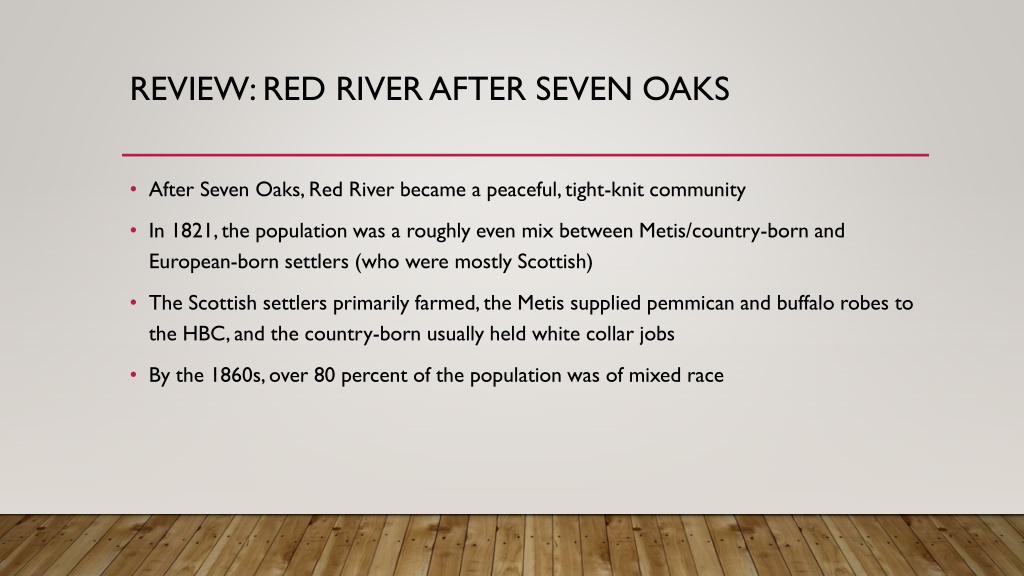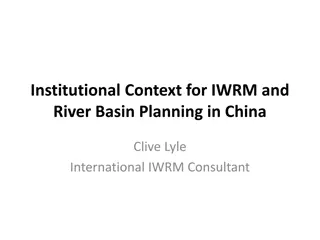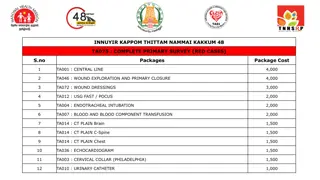Turbulent Times in Red River: A Historical Overview
Red River transitioned from a peaceful community to a land of tension as new settlers, primarily Protestant, arrived in the 1860s. Led by figures like John Christian Schultz, these settlers discriminated against the Metis and sought control over the settlement, leading to increased conflict as crop failures and economic pressures added to the turmoil. The Hudson's Bay Company's declining interest and negotiations for transfer of control to the Canadian government further fueled tensions.
Download Presentation

Please find below an Image/Link to download the presentation.
The content on the website is provided AS IS for your information and personal use only. It may not be sold, licensed, or shared on other websites without obtaining consent from the author. Download presentation by click this link. If you encounter any issues during the download, it is possible that the publisher has removed the file from their server.
E N D
Presentation Transcript
REVIEW: RED RIVER AFTER SEVEN OAKS After Seven Oaks, Red River became a peaceful, tight-knit community In 1821, the population was a roughly even mix between Metis/country-born and European-born settlers (who were mostly Scottish) The Scottish settlers primarily farmed, the Metis supplied pemmican and buffalo robes to the HBC, and the country-born usually held white collar jobs By the 1860s, over 80 percent of the population was of mixed race
CHANGE COMES TO RED RIVER In the 1860s, a new wave of settlers began to arrive in the Red River Settlement These new settlers were coming from Canada West/Upper Canada, as most of the land there had already been settled and The Red River was a desirable place for these farmers, as there was a small population and the land was suitable for farming Who does this remind you of?
THE NEW SETTLERS Most of these new settlers were Protestant and members of a group called the Orange Order They were violently opposed to the French and Catholics Furthermore, they viewed the Metis as subhuman because they were of mixed ancestry
DR. JOHN CHRISTIAN SCHULTZ John Christian Schultz called himself a doctor, but never completed his degree and had no interest in medicine Upon arriving in Red River, he formed a group called the Canadian Party, which he wanted to use to take over the settlement for the newer Protestant settlers He also purchased the NorWester, Red River s only newspaper and used it to promote anti-Metis hatred The Metis should either be driven from the country, or be kept as cart drivers The Metis like the Native tribes of the country, will fall back before the march of superior intelligence
FURTHER TENSIONS IN RED RIVER Red River began experiencing frequent crop failures in the 1860s Bison, for whom the Metis heavily relied upon, were becoming scarce The HBC was losing money due to the fur trade declining, and was beginning to lose interest in Red River as a support settlement This led the HBC to begin negotiating with the government to transfer control of Rupert s Land to the Canadian government
FROM SEA TO SHINING SEA When the Fathers of Confederation were writing the British North America act, they intended for Rupert s Land to eventually become part of the new country from the beginning John A. MacDonald and Thomas D Arcy McGee envisioned that the new country would stretch from the Atlantic all the way to the Pacific Ocean By acquiring Rupert s Land, they could extend the country to almost the Pacific Ocean
Neither the HBC nor the Canadian government consulted the people living in the Red River Settlement about the deal Even before the deal officially happened, the Canadian government sent land surveyors in 1868 to begin dividing up the new territory into grids for future settlement The surveyors assumed that the Red River s long-time residents did not own the land they farmed and ignored the seigneurial system This was technically true, as the Metis had not filed a formal claim to the land However, the Metis had been living and farming those lands for generations
LOUIS RIEL ARRIVES The same year that Canada began sending land surveyors to Rupert s Land, Louis Riel returned to Red River His father, Riel Sr., was the previous leader of the Metis people up until his death Riel was literate, well-educated, spoke both English and French, and was a skilled public speaker These qualities led Riel to succeed his father in leading the Metis, despite only being twenty-four at the time
RED RIVER RISING In addition to land surveyors, land speculators began arriving in Rupert s Land in 1869, people who bought and sold land for profit All these factors combined led to Riel and the Metis to start organizing to defend their land and their rights, which they feared were under threat Riel formed the Metis National Committee to represent and fight for his people s rights They confronted land surveyors, forcing them to turn back When William MacDougall, new governor of the Northwest Territory and Rupert s Land, attempted to enter it, he was turned back by a group of Metis This culminated in Riel and a force of 400 Metis seizing Fort Garry Thus, the Red River Rebellion had begun

















































